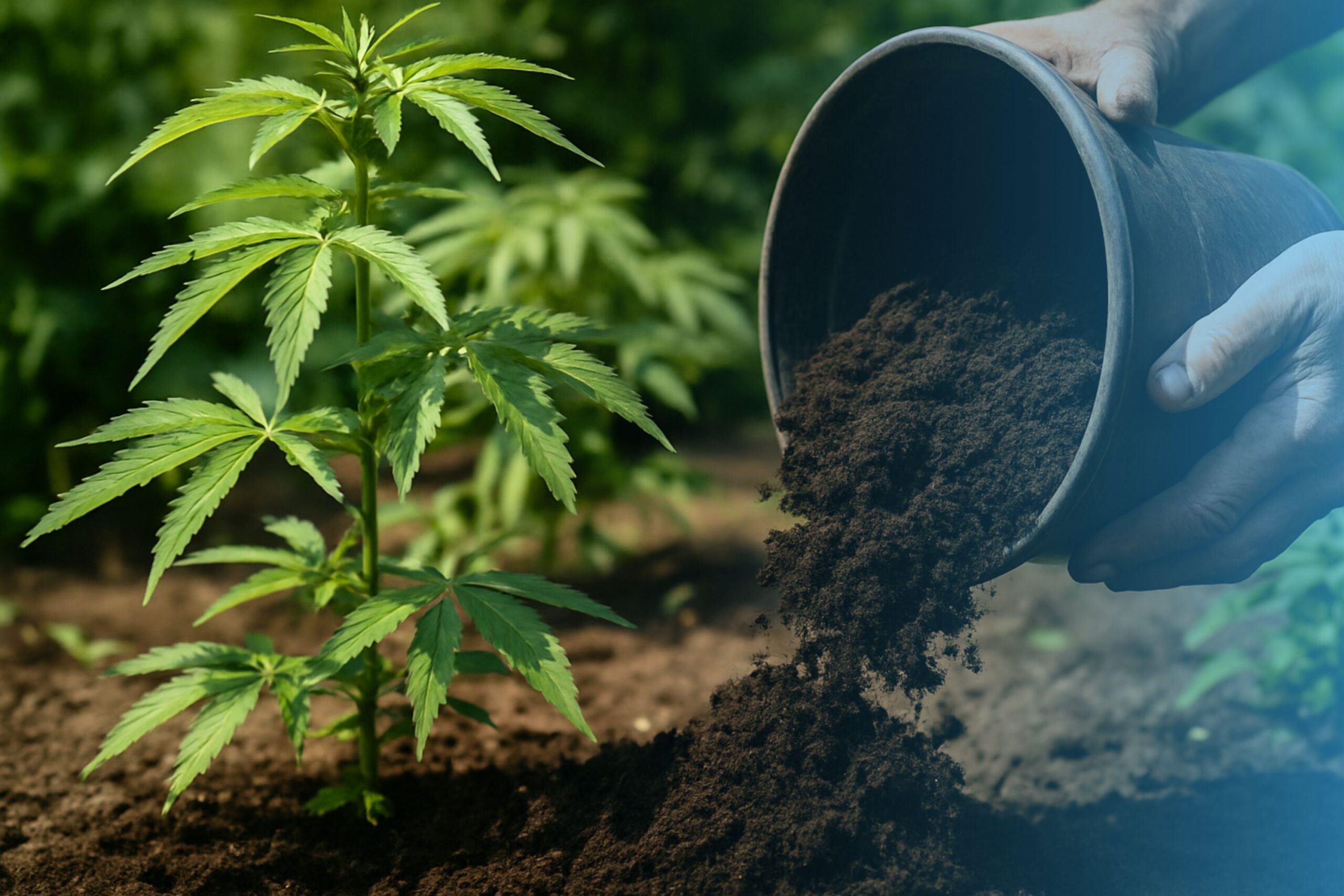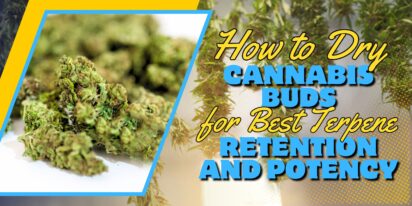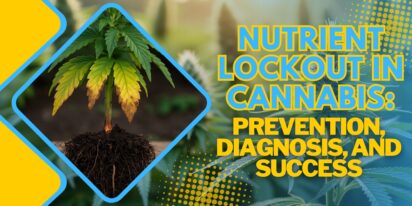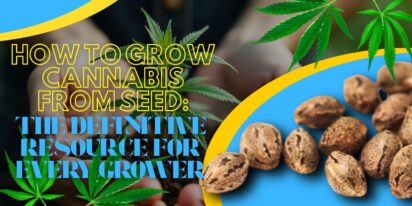Are You 21 Or Over?
YesOr
No By clicking yes, you certify that you are over 21 years old. By using this website, you agree to our legal disclaimer.Table of Contents

An appropriate outdoor grow nutrient schedule is essential for producing a plentiful harvest when cultivating cannabis outdoors. With an emphasis on when and how to provide nutrients to cannabis plants at different stages of their life cycles, this guide will take you through the fundamentals of managing your cannabis nutrient schedule. A high-quality harvest or a mediocre crop depends entirely on the timing and availability of the right nutrients. Let’s get started and discover the best way to feed weed plants.

Like all plants, cannabis plants need a range of nutrients to grow. Knowing what nutrients cannabis requires to grow healthily is crucial when starting an outdoor grow. Nitrogen (N), phosphorus (P), and potassium (K), or NPK, are the main nutrients needed by cannabis plants. Other vital secondary and micronutrients, such as calcium, magnesium, sulphur, iron, zinc, and copper, are also present. All of these factors affect your cannabis plant’s general health, and a balanced nutrient schedule will meet all of their requirements.

The seedling, vegetative, and flowering stages should be the divisions of an efficient cannabis nutrient schedule. Knowing when to start feeding seedlings and how to modify the feeding as your plants grow is essential because each stage has different nutritional needs.
Seedling Stage (Week 1-3): For a cannabis plant to develop strong roots and stems, the first few weeks of life are crucial. Your plants should rely on the nutrients in the soil during this period. Growth retardation and nutrient burn can result from overfeeding at this early stage. As a result, it is advisable to start a marijuana fertilizer schedule only after the seedlings have produced at least two or three sets of leaves. Choose a gentle, well-balanced nutrient mix when you do begin feeding. Steer clear of high nitrogen content since it can promote fast growth that the young plants might find challenging to control.
Vegetative Stage (Week 4-6): The cannabis plant concentrates on developing robust stems and leaves during this stage. Cannabis needs to be fed at this stage in order to maintain strong growth. In order to promote foliage growth, a higher nitrogen ratio is essential. In order to promote vegetative growth, a high percentage of nitrogen is usually present in a good cannabis plant feed at this stage. Maintaining moderate nutrient levels is crucial to prevent overfeeding, which could cause stress to the plant.
Flowering Stage (Week 7-10): Your plants will start to concentrate on making buds rather than growing leaves once they reach the flowering stage. Now is the time to switch to a marijuana fertilizer schedule that contains more potassium and phosphorus and less nitrogen. The development of flowers depends on these nutrients. Make sure your cannabis plant receives enough cannabis nutrients during flowering, particularly potassium, which aids in flower quality and yield, and phosphorus, which encourages the formation of flowers. During this stage, the plants may become more sensitive to high nutrient levels, so be careful not to overfeed.

It’s important to know when and how to feed weed plants. The secret to making sure weed plants are properly nourished but not overfed is to know what to feed them at each stage of their life cycle. As a general rule, begin with a mild, balanced nutrient solution and progressively increase the intensity as the plants get older.
Overfeeding cannabis plants, especially in their early stages, is a common mistake made by novice growers. A plant that receives too many nutrients may experience nutrient lockout, which prevents it from absorbing the nutrients it requires. This may cause the plant to die, have its growth stunted, or have its leaves turn yellow. As a result, you should always begin with a diluted nutrient solution and progressively raise the concentration as your plants develop.
Cannabis growers who grow their plants outdoors frequently struggle with nutrient deficiencies. When feeding cannabis, it’s important to pay close attention to how your plants react to their surroundings. Your plants probably need more of a certain nutrient if they are exhibiting symptoms like discoloration, slow growth, or yellowing leaves.
For example:
Adjust to Weather Conditions: Remember that natural weather fluctuations can affect outdoor grows. The way your cannabis plants absorb nutrients may be impacted by heavy rain or bright sunlight. If you need to change your feeding schedule, be ready to do so.
pH Levels Matter: Make sure your nutrient solution’s pH falls between 6.0 and 7.0, which is the ideal range for cannabis. Your plants may not be able to properly absorb nutrients if the pH is off.
Use Organic Fertilizers: Compost and fish emulsion are examples of organic fertilizers that can release nutrients gradually, making them better for the environment and your plants.
Flush Before Harvest: It’s crucial to give your cannabis plants a week or two of plain water to flush them out before harvesting. This enhances the taste and quality of your buds and aids in the removal of extra nutrients.
Cultivating vibrant, high-yielding cannabis plants requires perfecting your outdoor grow nutrient schedule. Understanding your plants’ unique nutrient requirements at every stage, from seedling to flowering, will help you provide them with the support they need to grow healthily, produce as many buds as possible, and steer clear of common problems like nutrient burn or deficiencies. Since overfeeding can be just as detrimental as underfeeding, timing and moderation are crucial. Don’t forget to keep a close eye on your plants and modify the nutrient ratios according to their growth and the surroundings.
In the end, knowledgeable, regular care is what makes an outdoor cannabis grow successful. You’ll have a successful garden if you use high-quality fertilizers, keep your pH levels in check, and spot any nutrient imbalances early. A well-planned feeding schedule will improve your outdoor cannabis crop and position you for a tasty and bountiful harvest, regardless of your level of experience.
1.When should I start feeding my cannabis plants nutrients?
You should begin feeding your cannabis plants once they have developed two to three sets of true leaves. Prior to that, they can usually rely on the nutrients in the soil.
2. How often should I feed my cannabis plants outdoors?
Outdoor cannabis plants typically need feeding once every 7 to 10 days during the vegetative and flowering stages, depending on the nutrient needs of the plant and the quality of the soil.
3. What nutrients does cannabis need during the flowering stage?
During the flowering stage, cannabis needs higher levels of phosphorus and potassium to promote bud development, while nitrogen levels should be lowered to prevent excess foliage growth.
4. Can I use store-bought cannabis fertilizers for my outdoor grow?
Yes, store-bought cannabis-specific fertilizers are great for outdoor grows. Be sure to choose one that’s designed for the specific stage of growth your plants are in.
5. What are the signs of overfeeding cannabis plants?
Overfeeding can result in nutrient burn, where the tips of the leaves turn yellow or brown. In extreme cases, the plant may show signs of wilting or stunted growth.

Curious about growing weed in a healthy, effective way? Welcome to the realm of weed hydro! This method uses water instead of soil, delivering n

Peyote Zkittlez is a unique cannabis strain that has quickly gained dedicated followers among enthusiasts and patients alike. Its parentage—Zk

As growers, we want strains that work well, are strong, and are of good quality. Autoflowering cannabis strains are a big step forward for both

Pot growers always ask the same basic question: How much weed does a weed plant produce? The answer is complex and depends on a multitude of var

Ever had the room spin after a few hits? You're not alone. Figuring out how to prevent getting dizzy high can make your cannabis experience a wh

Drying cannabis properly is a critical process in preserving the plant's full aroma and flavor and its psychoactive abilities. Tampering with th

Ever caught yourself a bit too high and all of a sudden in need of being normal? Whether you're heading out for munchies or bumping into someone

Looking for sage advice on how not to get pinched with weed without batting an eye? Attempting to protect your stash from gossipy roommates, sno

Nutrient lockout, also known as nutrient binding or chemical antagonism, is a significant issue in cannabis cultivation that negatively impacts

Germination is the most critical initial stage in growing healthy, high-quality cannabis plants. During germination, the dormant seed becomes a
Are You 21 Or Over?
YesOr
No By clicking yes, you certify that you are over 21 years old. By using this website, you agree to our legal disclaimer.
Excellent blog here Also your website loads up very fast What web host are you using Can I get your affiliate link to your host I wish my web site loaded up as quickly as yours lol
Your writing is not only informative but also incredibly inspiring. You have a knack for sparking curiosity and encouraging critical thinking. Thank you for being such a positive influence!
Simply wish to say your article is as amazing The clearness in your post is just nice and i could assume youre an expert on this subject Well with your permission let me to grab your feed to keep updated with forthcoming post Thanks a million and please carry on the gratifying work
Somebody essentially lend a hand to make significantly articles Id state That is the very first time I frequented your website page and up to now I surprised with the research you made to make this actual submit amazing Wonderful task
Your blog is a beacon of light in the often murky waters of online content. Your thoughtful analysis and insightful commentary never fail to leave a lasting impression. Keep up the amazing work!
Thank you for the auspicious writeup It in fact was a amusement account it Look advanced to more added agreeable from you By the way how could we communicate
Your blog is a constant source of inspiration for me. Your passion for your subject matter shines through in every post, and it’s clear that you genuinely care about making a positive impact on your readers.
Your blog is a constant source of inspiration for me. Your passion for your subject matter is palpable, and it’s clear that you pour your heart and soul into every post. Keep up the incredible work!
Your articles never fail to captivate me. Each one is a testament to your expertise and dedication to your craft. Thank you for sharing your wisdom with the world.
Your blog is a testament to your dedication to your craft. Your commitment to excellence is evident in every aspect of your writing. Thank you for being such a positive influence in the online community.
Your writing has a way of resonating with me on a deep level. I appreciate the honesty and authenticity you bring to every post. Thank you for sharing your journey with us.
Your blog is a true gem in the world of online content. I’m continually impressed by the depth of your research and the clarity of your writing. Thank you for sharing your wisdom with us.
Hi i think that i saw you visited my web site thus i came to Return the favore Im attempting to find things to enhance my siteI suppose its ok to use a few of your ideas
Somebody essentially help to make significantly articles Id state This is the first time I frequented your web page and up to now I surprised with the research you made to make this actual post incredible Fantastic job
Usually I do not read article on blogs however I would like to say that this writeup very compelled me to take a look at and do so Your writing taste has been amazed me Thanks quite nice post
Your blog has quickly become one of my favorites. Your writing is both insightful and thought-provoking, and I always come away from your posts feeling inspired. Keep up the phenomenal work!
Every time I visit your website, I’m greeted with thought-provoking content and impeccable writing. You truly have a gift for articulating complex ideas in a clear and engaging manner.
Hey there You have done a fantastic job I will certainly digg it and personally recommend to my friends Im confident theyll be benefited from this site
I have read some excellent stuff here Definitely value bookmarking for revisiting I wonder how much effort you put to make the sort of excellent informative website
Nice blog here Also your site loads up very fast What host are you using Can I get your affiliate link to your host I wish my site loaded up as quickly as yours lol
What i do not understood is in truth how you are not actually a lot more smartlyliked than you may be now You are very intelligent You realize therefore significantly in the case of this topic produced me individually imagine it from numerous numerous angles Its like men and women dont seem to be fascinated until it is one thing to do with Woman gaga Your own stuffs nice All the time care for it up
Your blog is a beacon of light in the often murky waters of online content. Your thoughtful analysis and insightful commentary never fail to leave a lasting impression. Keep up the amazing work!
Your blog is a breath of fresh air in the often stagnant world of online content. Your thoughtful analysis and insightful commentary never fail to leave a lasting impression. Thank you for sharing your wisdom with us.
Your blog is a beacon of light in the often murky waters of online content. Your thoughtful analysis and insightful commentary never fail to leave a lasting impression. Keep up the amazing work!
Usually I do not read article on blogs however I would like to say that this writeup very compelled me to take a look at and do it Your writing style has been amazed me Thank you very nice article
Your writing has a way of resonating with me on a deep level. I appreciate the honesty and authenticity you bring to every post. Thank you for sharing your journey with us.
This hydroponics guide is quite the buzz, seriously! Who knew growing weed without dirt could be so complicated yet potentially rewarding? The breakdown of systems like DWC and NFT is helpful, though I suspect my cat might confuse the air pump for a toy. The idea of cleaner buds is tempting, especially since explaining hydro weed to my non-growing friends might get messy. And the bit about potential dizziness from hydro weed? Perfect, now I have an excuse for why I always stumble a bit after a grow session. Still, the promise of faster grows and higher yields is hard to ignore, even if it means more trips to the pH meter than to the coffee shop. Overall, a cultivating read for the curious grower!